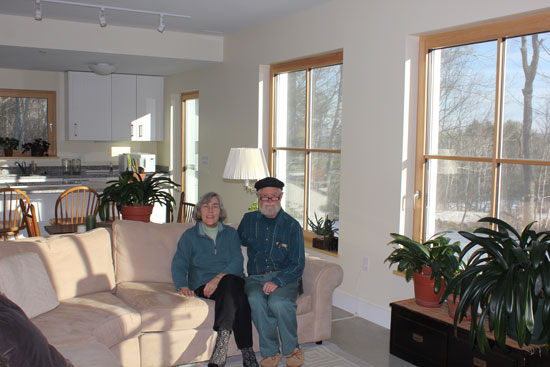Transitioning to a Net-Zero Home

[Sarah Lozanova is an environmental journalist and communications professional with an MBA in sustainable management. She recently relocated to BelfastCohousing & Ecovillage in Midcoast Maine with her husband and two children. The article was published in motherearthliving.com]
Jeffrey and Judith loved living in the quaint harbor town of Belfast, Maine, with waterfront views. They resided in a large seaside home where an estuary formed as Little River met Penobscot Bay. However, significant time and resources were needed to maintain and heat the home with oil and wood. Although Jeffrey and Judith enjoyed entertaining and spending time by the bay, they decided to list their home for sale and move into a net-zero energy home at Belfast Cohousing & Ecovillage.
“Everyone knows that Americans consume resources at a rate that is not sustainable,” Jeffrey says. “I always thought I was making my contribution by recycling and driving an economical vehicle. At the same time I was living in an enormous house that, in a third world country, could house 10 families. Before we insulated the attic we were using close to a thousand gallons of oil each year. This is not a sustainable number for two families, as we had a rental apartment in the home.”
Belfast Maine Net Zero Home
The Benefits of Their New Net-Zero Home
Their new 1,500-square-foot, high-performance home is primarily heated by passive solar gains, appliances and even occupants. A modest 4.5 kW solar system produces all the power the family uses over the course of the year. Because the home is all electric, solar energy heats the water and home, and powers appliances.
Transitioning To A Net Zero Home
How to Plan a Net-Zero Home
When planning a net-zero home, it’s wise to start with energy efficiency. Jeffrey and Judith’s home has generous amounts of insulation in the foundation, roof and walls; lots of large south-facing triple-pane windows; and is oriented for maximum solar gain. The slab-on-grade foundation warms up on sunny winter days, slowly releasing the heat when temperatures drop. The home is air-sealed, making it virtually airtight. Even on cold, windy, winter days, the couple can sit in front of the windows and feel no drafts.
To ensure high quality air and comfort, the home has a Zehnder heat recovery ventilator. It supplies a constant stream of fresh, filtered air to the bedrooms and office, while extracting stale air from the kitchen and bathrooms. Heat in the winter or coolness in the summer is recycled from the exhaust air to the intake air, ensuring a high level of energy efficiency and comfort. Unlike many traditional homes where air enters through leaks in the walls, comes up from the basement or crawl space, or in through an attached garage—the outside air intake on Jeffrey and Judith’s home is strategically placed to avoid bringing toxins, radon or mold into the home.
In a less-efficient home, the 4.5 kW solar system would not be sufficient to generate all the energy the home consumes. Jeffrey and Judith found a winning combination of efficiency and renewable power generation to make a net-zero home possible.
The 36-unit community of high-performance homes is clustered to preserve open space for agriculture, wildlife and recreation. Although Jeffery and Judith’s new home doesn’t have views of the bay, it does overlook Little River Community Farm. The worker-share farm members gather each week to harvest vegetables and maintain the land.
“My wife and I are making our ‘seventh generation’ contribution now,” Jeffrey explains. “We want our grandchildren and future generations to live in a world that is as green and beautiful as this one is now.”
Category: Green Living
Tags: Design, Ecohousing, Green, sustainability
Views: 873

